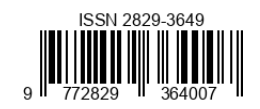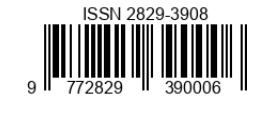Application of Collaborative Project Learning Methods in PPKn Subjects Grades 11-5 SMAN 1 Kedamean Gresik
DOI:
https://doi.org/10.56910/literacy.v4i1.2174Keywords:
Learning Methods, Collaborative Projects, PPKn, Students, SMAN 1 Kedamean GresikAbstract
This study aims to determine the application of collaborative project learning methods in PPKn subjects in grades 11-5 of SMAN 1 Kedamean Gresik. This method helps students learn in groups, while improving social and communication skills, as well as problem-solving skills. In addition, this method can make the learning process more interesting and interactive, thus encouraging students to play a more active role during the learning process. This study uses a descriptive qualitative method with data collection techniques through observation, interviews, and documentation. To ensure the accuracy of the data obtained, source triangulation and triangulation techniques are used. The data analysis techniques used with Miles and Huberman's steps are data collection, data reduc-tion, data presentation, and data verification. The results of the study show that the application of this collaborative project learning method improves learning outcomes and student involvement in learning. They are freer in discussing, developing ideas, and easier to understand PPKn learning materials. However, there are still some obstacles faced, such as the imbalance of individual roles in the group and the limited time to complete projects carried out by students.
References
[1] F. S. Fujiawati, “Pemahaman konsep kurikulum dan pembelajaran dengan peta konsep bagi mahasiswa pendidikan seni,” JPKS (Jurnal Pendidikan dan Kajian Seni), vol. 1, no. 1, Apr. 2016, doi: 10.30870/JPKS.V1I1.849.
[2] F. D. Insani, “Sejarah perkembangan kurikulum di Indonesia sejak awal kemerdekaan hingga saat ini,” As-Salam: Jurnal Studi Hukum Islam & Pendidikan, vol. 8, no. 1, pp. 43–64, Jun. 2019, doi: 10.51226/ASSALAM.V8I1.132.
[3] A. Q. Zaman, I. Irnawati, and P. R. Widyatama, “PPKn teachers’ efforts in understanding students through the merdeka belajar curriculum,” JED (Jurnal Etika Demokrasi), vol. 8, no. 4, pp. 459–468, Nov. 2023, doi: 10.26618/JED.V8I4.13077.
[4] I. Ramadhan, “Kurikulum merdeka: Proses adaptasi dan pembelajaran sosiologi di sekolah menengah atas,” Journal of Educa-tion Research, vol. 4, no. 4, pp. 1846–1853, Nov. 2023, doi: 10.37985/JER.V4I4.348.
[5] S. R. Setiyorini and D. Setiawan, “Perkembangan kurikulum terhadap kualitas pendidikan di Indonesia,” Jurnal Teknologi Pen-didikan, vol. 1, no. 1, pp. 12–12, Oct. 2023, doi: 10.47134/JTP.V1I1.27.
[6] D. Kokotsaki, V. Menzies, and A. Wiggins, “Project-based learning: A review of the literature,” Improving Schools, vol. 19, no. 3, pp. 267–277, Nov. 2016, doi: 10.1177/1365480216659733;WGROUP:STRING:PUBLICATION.
[7] F. Dewi, “Proyek buku digital: Upaya peningkatan keterampilan abad 21 calon guru sekolah dasar melalui model pembelaja-ran berbasis proyek,” Metodik Didaktik, vol. 9, no. 2, pp. 1–15, 2015, doi: 10.17509/MD.V9I2.3248.
[8] P. R. Widyatama, M. Muhajir, and N. Huda, “Students’ views on multimedia in differentiated learning of Pancasila education at SMA Muhammadiyah 10 Surabaya,” Journal of Educational Sciences, vol. 9, no. 2, pp. 782–801, Mar. 2025, doi: 10.31258/JES.9.2.P.782-801.
[9] D. Baser, M. Y. Ozden, and H. Karaarslan, “Collaborative project-based learning: an integrative science and technological education project,” Research in Science & Technological Education, vol. 35, no. 2, pp. 131–148, Apr. 2017, doi: 10.1080/02635143.2016.1274723.
[10] P. Wati, T. Nusantara, and C. Utama, “Efektivitas PjBL-STEM terhadap keterampilan berpikir kritis dan motivasi belajar siswa sekolah dasar,” Cetta: Jurnal Ilmu Pendidikan, vol. 7, no. 2, pp. 126–143, May 2024, doi: 10.37329/CETTA.V7I2.3264.
[11] S. P. Napitupulu and E. Murniarti, “Analisis keterlibatan siswa menengah pertama dalam pembelajaran berbasis proyek pada kurikulum merdeka,” Jurnal Kepemimpinan dan Pengurusan Sekolah, vol. 9, no. 2, pp. 172–178, Jun. 2024, doi: 10.34125/JKPS.V9I2.450.
[12] K. H. D. Tang, “Student-centered approach in teaching and learning: What does it really mean?,” Acta Pedagogia Asiana, vol. 2, no. 2, pp. 72–83, Mar. 2023, doi: 10.53623/APGA.V2I2.218.
[13] F. Kristin and S. N. Ubaidila, “Penerapan Model Pembelajaran Project Based Learning untuk Meningkatkan Hasil Belajar IPAS Siswa Kelas IV Sekolah Dasar,” Jurnal Inovasi, Evaluasi dan Pengembangan Pembelajaran (JIEPP), vol. 4, no. 3, pp. 371–380, Dec. 2024, doi: 10.54371/JIEPP.V4I3.531.
[14] N. M. R. Kusadi, I. P. Sriartha, and I. W. Kertih, “Model pembelajaran project based learning terhadap keterampilan sosial dan berpikir kreatif,” Thinking Skills and Creativity Journal, vol. 3, no. 1, pp. 18–27, Apr. 2020, doi: 10.23887/TSCJ.V3I1.24661.
[15] Muh. Zein, “Peran guru dalam pengembangan pembelajaran,” Inspiratif Pendidikan, vol. 5, no. 2, pp. 274–285, Jul. 2016, doi: 10.24252/IP.V5I2.3480.
[16] Okpatrioka and M. Abdullah, “Pengembangan kurikulum berbasis keterampilan abad ke-21: Perspektif dan tantangan,” IKRA-ITH HUMANIORA : Jurnal Sosial dan Humaniora, vol. 8, no. 3, pp. 322–340, Nov. 2024, doi: 10.37817/ikraith-humaniora.
[17] A. Rehani and T. A. Mustofa, “Implementasi project based learning dalam meningkatkan pola pikir kritis siswa di SMK Negeri 1 Surakarta,” Didaktika: Jurnal Kependidikan, vol. 12, no. 4, pp. 487–496, Nov. 2023, doi: 10.58230/27454312.273.
[18] Barnida, Dermawan, and S. Nur, “Upaya guru PPKn dalam menanamkan nilai-nilai moral,” Journal Peqguruang: Conference Se-ries, vol. 1, no. 2, pp. 78–83, Nov. 2019, doi: 10.35329/JP.V1I2.556.
[19] A. I. Zulkarnain, A. F. R. Indarto, M. A. R. Ramadhan, and R. A. Firdaus, “Dampak pendidikan kewarganegaraan terhadap pemahaman hak dan kewajiban warga negara bagi siswa,” Journal of Innovative and Creativity, vol. 5, no. 2, pp. 350–362, Apr. 2025, doi: 10.31004/JOECY.V5I2.173.
[20] H. A. C. Lopera, E. Gutierrez-Velasquez, and N. Ballesteros, “Bridging the Gap Between Theory and Active Learning: A Case Study of Project-Based Learning in Introduction to Materials Science and Engineering,” Revista Iberoamericana de Tecnolo-gias del Aprendizaje, vol. 17, no. 2, pp. 160–169, May 2022, doi: 10.1109/RITA.2022.3166862.
[21] N. Amelia and N. Aisya, “Model pembelajaran berbasis proyek (project based learning) dan penerapannya pada anak usia dini di TK IT Al-Farabi,” BUHUTS AL ATHFAL: Jurnal Pendidikan dan Anak Usia Dini, vol. 1, no. 2, pp. 181–199, Dec. 2021, doi: 10.24952/ALATHFAL.V1I2.3912.
[22] A. Q. Zaman, I. Irnawati, and P. R. Widyatama, “PPKn Teachers’ Efforts in Understanding Students Through the Merdeka Belajar Curriculum,” JED (Jurnal Etika Demokrasi), vol. 8, no. 4, pp. 459–468, Nov. 2023, doi: 10.26618/JED.V8I4.13077.
[23] Sugiyono, Metode Penelitian Kuantitatif, Kualitatif, dan R&D, 2nd ed., vol. 6. CV. Alfabeta, 2024.
[24] S. J. Stratton, “Population research: Convenience sampling strategies,” Prehosp Disaster Med, vol. 36, no. 4, pp. 373–374, Aug. 2021, doi: 10.1017/S1049023X21000649.
[25] I. Etikan, S. A. Musa, and R. S. Alkassim, “Comparison of convenience sampling and purposive sampling,” American Journal of Theoretical and Applied Statistics 2016, Volume 5, Page 1, vol. 5, no. 1, pp. 1–4, Dec. 2015, doi: 10.11648/J.AJTAS.20160501.11.
[26] J. Zajda, “Constructivist learning theory and creating effective learning environments,” pp. 35–50, 2021, doi: 10.1007/978-3-030-71575-5_3.
[27] P. E. Doolittle, “Understanding cooperative learning through Vygotsky’s zone of proximal development,” 1995.
[28] K. Shabani, M. Khatib, and S. Ebadi, “Vygotsky’s zone of proximal development: Instructional implications and teachers’ professional development,” English Language Teaching, vol. 3, no. 4, pp. 237–248, Dec. 2010, Accessed: May 19, 2025. [Online]. Available: www.ccsenet.org/elt
[29] A. Rofiudin, A. Prasetya, and D. Dwi Prasetya, “Pembelajaran kolaboratif di SMK: Peran kerja sama siswa dalam mening-katkan keterampilan soft skills,” Journal of Education Research, vol. 5, no. 4, pp. 4444–4455, Sep. 2024, doi: 10.37985/JER.V5I4.672.
[30] E. H. Ramadhan and Hindun, “Penerapan model pembelajaran berbasis proyek untuk membantu siswa berpikir kreatif,” Protasis: Jurnal Bahasa, Sastra, Budaya, dan Pengajarannya, vol. 2, no. 2, pp. 43–54, Dec. 2023, doi: 10.55606/PROTASIS.V2I2.98.
Downloads
Published
How to Cite
Issue
Section
License
Copyright (c) 2025 LITERACY : International Scientific Journals of Social, Education, Humanities

This work is licensed under a Creative Commons Attribution-ShareAlike 4.0 International License.







